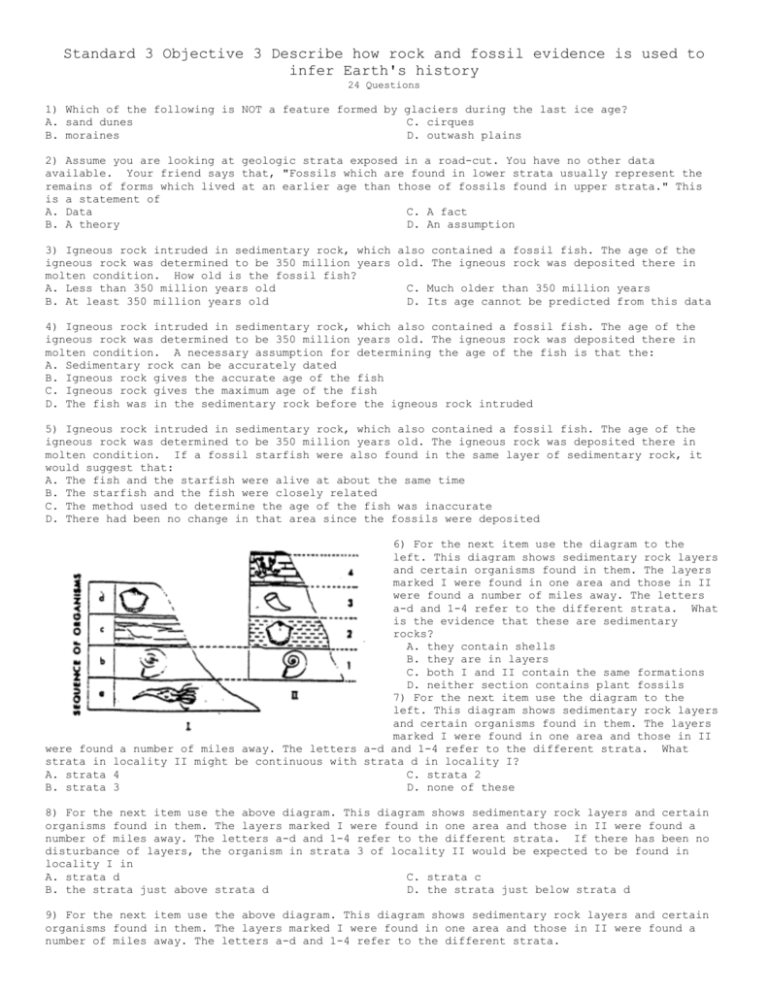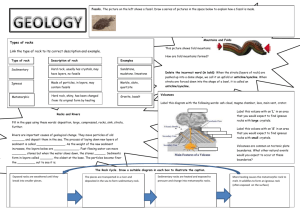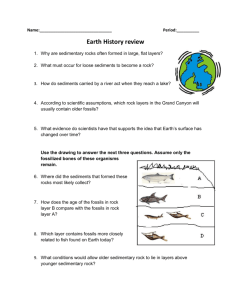Standard 3 Objective 3 Describe how rock and fossil evidence is
advertisement

Standard 3 Objective 3 Describe how rock and fossil evidence is used to infer Earth's history 24 Questions 1) Which of the following is NOT a feature formed by glaciers during the last ice age? A. sand dunes C. cirques B. moraines D. outwash plains 2) Assume you are looking at geologic strata exposed in a road-cut. You have no other data available. Your friend says that, "Fossils which are found in lower strata usually represent the remains of forms which lived at an earlier age than those of fossils found in upper strata." This is a statement of A. Data C. A fact B. A theory D. An assumption 3) Igneous rock intruded in sedimentary rock, which also contained a fossil fish. The age of the igneous rock was determined to be 350 million years old. The igneous rock was deposited there in molten condition. How old is the fossil fish? A. Less than 350 million years old C. Much older than 350 million years B. At least 350 million years old D. Its age cannot be predicted from this data 4) Igneous rock intruded in sedimentary rock, which also contained a fossil fish. The age of the igneous rock was determined to be 350 million years old. The igneous rock was deposited there in molten condition. A necessary assumption for determining the age of the fish is that the: A. Sedimentary rock can be accurately dated B. Igneous rock gives the accurate age of the fish C. Igneous rock gives the maximum age of the fish D. The fish was in the sedimentary rock before the igneous rock intruded 5) Igneous rock intruded in sedimentary rock, which also contained a fossil fish. The age of the igneous rock was determined to be 350 million years old. The igneous rock was deposited there in molten condition. If a fossil starfish were also found in the same layer of sedimentary rock, it would suggest that: A. The fish and the starfish were alive at about the same time B. The starfish and the fish were closely related C. The method used to determine the age of the fish was inaccurate D. There had been no change in that area since the fossils were deposited 6) For the next item use the diagram to the left. This diagram shows sedimentary rock layers and certain organisms found in them. The layers marked I were found in one area and those in II were found a number of miles away. The letters a-d and 1-4 refer to the different strata. What is the evidence that these are sedimentary rocks? A. they contain shells B. they are in layers C. both I and II contain the same formations D. neither section contains plant fossils 7) For the next item use the diagram to the left. This diagram shows sedimentary rock layers and certain organisms found in them. The layers marked I were found in one area and those in II were found a number of miles away. The letters a-d and 1-4 refer to the different strata. What strata in locality II might be continuous with strata d in locality I? A. strata 4 C. strata 2 B. strata 3 D. none of these 8) For the next item use the above diagram. This diagram shows sedimentary rock layers and certain organisms found in them. The layers marked I were found in one area and those in II were found a number of miles away. The letters a-d and 1-4 refer to the different strata. If there has been no disturbance of layers, the organism in strata 3 of locality II would be expected to be found in locality I in A. strata d C. strata c B. the strata just above strata d D. the strata just below strata d 9) For the next item use the above diagram. This diagram shows sedimentary rock layers and certain organisms found in them. The layers marked I were found in one area and those in II were found a number of miles away. The letters a-d and 1-4 refer to the different strata. Providing no geological shifts have taken place, the organism in A. strata a is the oldest C. strata d is the oldest B. strata d is the simplest D. strata a is the simplest 10) For the next item use the above diagram. This diagram shows sedimentary rock layers and certain organisms found in them. The layers marked I were found in one area and those in II were found a number of miles away. The letters a-d and 1-4 refer to the different strata. Increase of complexity of organisms through time A. is clearly show here C. cannot be inferred from the picture B. is indicated by position in rock strata D. is not possible 11) Use this diagram of a road cut to answer the following question. What event created the offset of layers J and I? A. erosion B. an earthquake C. folding D. a volcano 12) Use this diagram of a road cut to answer the following question. What event happened at the area labeled by the heavy black line? A. erosion B. an earthquake C. folding D. a volcano 13) Use this diagram of a road cut to answer the following question. the oldest? A. A C. I B. F D. J Which layer on the diagram is 14) The next item refers to the drawing of a hillside that was excavated for a highway. Layer III is coal and layer IV contains fossil starfish and sharks teeth. The clues in these layers suggest that the environment changed in a past age from: A. saltwater to land B. saltwater to freshwater C. land to freshwater D. freshwater to saltwater E. freshwater to land 15) The next item refers to the drawing of a hillside that was excavated for a highway. The six layers of rock show no evidence that they have been disturbed or rearranged by earth movements. Geologists assume that the oldest layer is: A. VI D. II B. IV E. I C. III 16) An excavation exposes the side of a hill. Rock layers of different colors, thicknesses, and textures are revealed as shown in the sketch above. Examine the figure and answer the question that follows. Fossil remains found in layer II are almost identical to a species of toad now living on the hillside. The best explanation is that: A. Toads can withstand great changes in the local environment B. This species of toad hopped there from a different hillside C. The evolution of this species of toad has been slow D. Changes occur often in generations of toads 17) An excavation exposes the side of a hill. Rock layers of different colors, thicknesses, and textures are revealed as shown in the sketch above. Examine the figure and answer the question that follows. Which one of the following assumptions is made by biologists considering fossils found at various levels? A. Fossil communities had the same physical environment as the present living community B. Each layer contains fossils that are older as you go from layer I to layer VI C. Each layer contains fossils that are more recent as you go from layer I to layer VI D. An animal could burrow into any layer and become fossilized 18) An excavation exposes the side of a hill. Rock layers of different colors, thicknesses, and textures are revealed as shown in the sketch above. Examine the figure and answer the question that follows. Shark teeth, many fossil sand dollars, and starfish are found in layer IV. This is a good indication that: A. Layer IV was on the shore of a large lake B. Layer IV was deposited in an ocean basin C. Considerable shifting of layers occurred as the layers were deposited D. A food chain was established during this period 19) As you look at rock "A" above, which of the following methods of determining the relative age of rocks would likely be the easiest for a middle school student to tell approximately how old the rock is? A. Do a Carbon 14 test C. Check the chart of index fossils B. Check the half-life of radon D. Measure the size of the crystals 20) Which two of the above samples would most likely help scientists learn about conditions deep below the surface of the earth as the above rocks formed? A. A and D C. A and B B. B and C D. C and D 21) Which rock formation is the youngest? A. A B. B C. C D. D 22) The development of radioactive dating technology allowed scientists to accurately find the age of rocks. How did this technology influence the advancement of our understanding of Earth history? A. Scientists found out that Earth’s core was younger than the crust. B. Scientists discovered that rocks are about the same age. C. Scientists confirmed that rock layers are youngest on the top. D. Scientists discovered that fossil age does not match the age of rocks. 23) Scientists collected fossils long before they knew the ages and relationships of one ancient organism to another. What additional knowledge was needed to form the modern view of prehistoric Earth history? A. A way to date the age of the rocks that the fossils were found in. B. A book to explain the way Earth formed and life developed. C. A collection of the types of rocks found in the rock cycle. D. A key to name the types of animals found in ancient times. 24) What evidence do scientists have that supports the idea that Earth’s surface has changed over time? A. fossils of rainforest plants in areas that are deserts today. B. rocks that came from outer space C. modern plants and animals that look like ancient organisms. D. climates in some places on Earth that are different than other places.






